What is Big Data? Overview
Table of Contents
In today’s world, a large amount of information needs to be processed. This large volume of data must be structured and processed by computers. This volume of information is called big data. In this article, we examine what big data is and explain big data in a very simple way.
What is Big Data?
Big data means a huge amount of structured and unstructured data that has the potential to help organizations improve their operations and make faster and smarter decisions. The number of these data is so much that it was difficult to process them using traditional databases and existing software.
In most organizations, the amount of data is too large or moving too fast and has exceeded the organization’s current processing capacity. Besides these problems, Big Data has the potential to help companies improve their operations and make faster and smarter decisions.
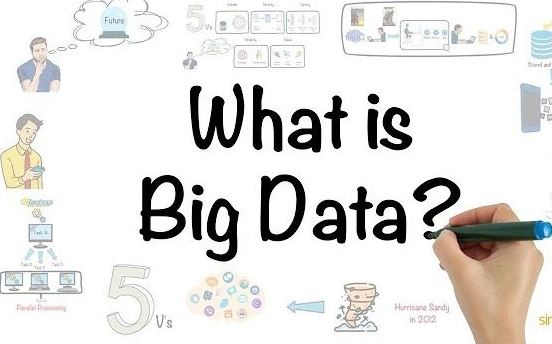
Currently, all big businesses are involved with this concept. Now that we are familiar with the concept of big data, in the rest of the article, we will examine the details and characteristics of big data.
What is Big Data Structure?
Since big data takes a lot of time and money to load into traditional databases for analysis. Big data analysis has given rise to new methods for data analysis and storage that pay less attention to the pattern and volume of data. Instead, raw data is collected locally and analyzed by machine learning and artificial intelligence to find recurring patterns using highly complex algorithms.
Then these iterative algorithms are used and analyze the data. With this method, there is no need to process all the data independently one by one. It is enough to extract the output results of the used algorithms, and use them for analysis and processing.
Features of Big Data
Big data is characterized by three main characteristics:
- Volume
- Speed
- Variety
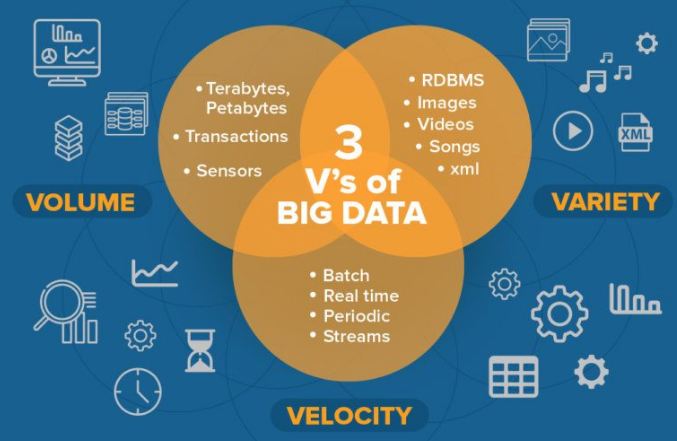
These features are not only related to big data. It also refers to the technology of storing and processing this information. This technology includes tools and processes that need to call very large unstructured data.
Volume: The volume of data is important in big data analysis because big data will include all types of wrong, unprocessed, correct, processed, etc.
Speed: The speed of receiving information is very high due to the simultaneous use of the Internet and data storage.
Variety: The variety of Big Data data is very high because they include a large range of data types such as sound, image, text, video, etc.
Big Data Types
Considering the importance of concepts related to big data, it is better to get familiar with its types. Generally, big data is divided into the following types:
Structured Data
It refers to data that has a proper structure and is suitable for use in large projects. For example, data in databases, Excel files, and spreadsheets all fall under the category of structured data.
Semi-Structured Data
These are data that do not match the formal structure of data models associated with relational databases or other forms of data tables. However, the semi-structured data contains tags to separate semantic elements and hierarchical implementation of records and data fields.
For example, data in e-mails, report files, and Word documents are classified as semi-structured data.
Unstructured Data
These are data that are widely available in the virtual space and lack any coherence and structure that we see in relation to databases. More precisely, while unstructured data has an internal structure, it does not follow consistent management patterns or data models.
In general, this data is unstructured. Among the obvious examples of these data, we should mention image, audio, and video files, all of which lack a conventional coherent structure.
Big Data 8 Vs
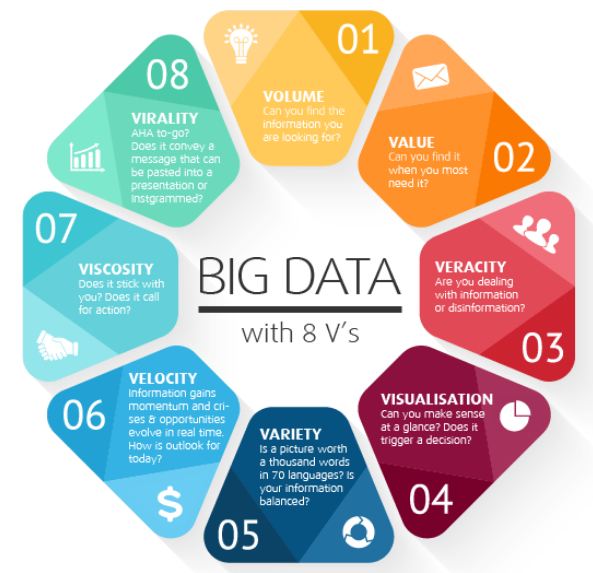
- Volume: Data volume is growing exponentially. There are various sources such as social networks, web server logs, traffic streams, satellite images, audio streams, bank transactions, the content of web pages, government documents, etc., which produce a large amount of data.
- Velocity: Data is generated in real-time at a very high speed through many applications and sensors in the environment. Many applications need to respond to user requests as soon as data is entered. In some cases, we may not be able to wait long enough for, for example, a report to be processed in the system for a long time.
- Variety: There are many types of data sources and variety in data types, as a result of which there are many data structures. For example, on the web, people use different software and browsers to send information. Because the more variation, there is, the more error there is.
- Veracity: Considering that data is received from different sources, it may not be possible to trust all of them. the second definition applies to big data generators in order to generate data that reflects the characteristics of the original data.
- Validity: Assuming that the data is correct, it may not be suitable for some applications, or in other words, it may not have enough validity to be used in some applications.
- Volatility: The rate of change of different data values over time can be different. Increasing the data retention period will certainly involve a lot of implementation costs that should be considered.
- Visualization: One of the difficult tasks in the field of big data is to display information. It is possible to make the huge amount of information with complex connections well understandable and study able through appropriate analytical and visualization methods.
- Value: This refers to how much data is valuable in terms of information for decision-making. Usually, data can be moved in different layers. Higher layers mean more data value. Therefore, some organizations can accept the high cost of maintenance related to higher layer
Applications of Big Data
Big data information is used for all kinds of business activities, marketing, market analysis, etc. Companies use big data collected on their systems to improve operations, provide after-sales services, and advertise campaigns to increase profitability. Some of the applications of big data are as follows:
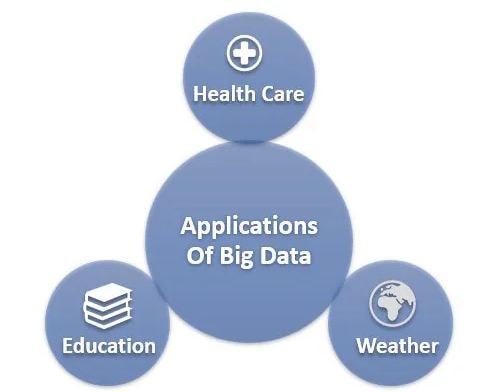
- Decision support for retaining and attracting customers: From the analysis of big data in surveys and checking the interests and tastes of customers, appropriate decisions can be made to attract new customers and provide the requests of old customers.
- Product development: Big data can effectively help manufacturers to design and develop the right product by classifying the key features of successful products and modeling the commercial success of products.
- Anticipation of troubleshooting: By reviewing error messages and reported problems, they will be used for modeling and manufacturing cost-effective and efficient equipment and parts.
- Operational efficiency: By planning in accordance with the number of assets and financial considerations, it led the production towards more demand.
Impact of Big Data on Digital Marketing
Today, co-marketing decisions require big data. Complex data and large numbers cannot be processed with traditional programs and require appropriate technology. Among the effects of big data in digital marketing, the following can be mentioned:
- More successful campaigns: Campaigns that use more data will be more successful. In these campaigns, instead of guessing, the behavior of customers and their buying patterns are correctly predicted and implemented.
- Better decision-making for pricing: more data will provide you with a more appropriate pricing solution by saving time and using many factors such as competitors’ prices, the status of their transactions, the amount of demand, etc.
- Creating appropriate web content: With large and effective data at your disposal, you can create your website content based on the interests of your target audience.
Sources of Big Data
Now that we are familiar with Big Data, it is good to know which sources provide this information.
- Media: The most popular and fastest way to find the behavioral pattern of the population
- Web: A large and varied collection of data available to individuals and companies.
- Internet of Things: This data, which is usually generated from sensors connected to electronic devices, has the possibility of providing accurate information in real-time.
- Databases: Various types of data sources such as MS Access, DB2, Oracle, SQL, and Amazon Simple allow the extraction and analysis of acquired data.
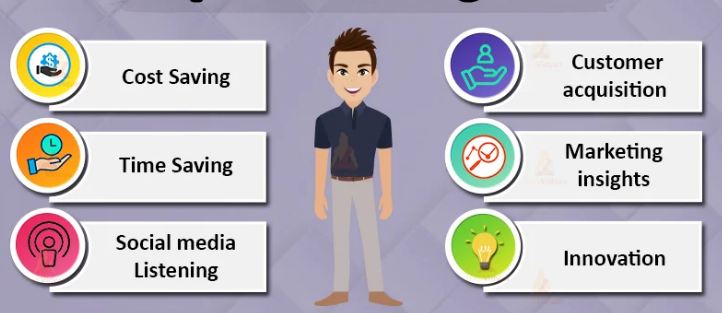
Big Data Analysis
By entering the age of information and communication, there was a concern that the same type of data is produced every day at a terrible speed in the world. Now how this large and diverse amount of data and information can be managed, controlled, and processed according to the structure that exists in IT.
From 2012 onwards, more than a thousand petabytes of data are generated every day, which requires storage, analysis, searches, data cleaning, subscriptions, etc. It should be done in different areas.
This issue has caused researchers and scientists to seek to create new structures, methodologies, methods, and approaches to manage, control, and process this volume of data. And these efforts have been raised under the shadow of “big data”.
Types of Big Data Analysis
5 main methods are considered for big data analysis:
- Descriptive analysis: This type of analysis looks at the past, and by using summary statistics, it explores the clustering and segmentation of the details of events at a particular time or in the past.
- Predictive Analytics: Predictive analytics attempts to predict the future using statistics, modeling, data mining, and machine learning to suggest patterns.
- Prospective analytics: Along with descriptive and predictive analytics, this is one of the three main types of analytics companies use to analyze data.
- Diagnostic analysis: This analysis is used to determine the cause of something and uses methods such as data mining, drilling and correlation to analyze the situation.
- Cyber analytics: This analytics is a combination of cyber security skills and data analytics knowledge. Using advanced tools and software, it identifies and predicts vulnerabilities and closes the way of attacks.
Big Data Tools
Choosing the most useful big data analysis tool is very important. In the following, we will name the most well-known big data analysis tools:
- Xplenty: A cloud-based service used for cleaning and consolidating data.
- Improvado: A tool to help all types of small businesses find and sort the data they want.
- Analytics: It is a dashboard that will enable graphical and visual analysis and integration of different sources for you.
- Skytree: One of the best tools for creating accurate forecasting models
- Spark: A tool for big data analysis and processing
- Hadoop: An open-source platform for large-scale data processing
Big Data Hadoop
All Companies need to manage their vast amount of data in a smart, cheap, and progressive way. One solution is to use tools like Hadoop, an open-source software framework used for large-scale data processing.
In fact, Hadoop is a framework or a set of software and libraries that provides a mechanism for processing a large amount of distributed data. This collection has been launched in 2006.
Hadoop is just like an operating system designed to process and manage large amounts of data on multiple machines. Hadoop managed to break the record for the fastest processing system in 2008 by processing 1 terabyte of data in 202 seconds. And even later announced that it had reduced this time to 68 seconds.
Big Data Vs Meta Data
Volume of data: With big data, you are faced with a large volume of unstructured and low-density data. This data can include data with unknown values such as Twitter data, clicks on a web page or data from a sensor. For some organizations, this means tens of terabytes of data.
Velocity: Speed refers to the rate of receiving and in some cases performing actions on data. For example, some Internet-based smart tools need to receive information in real-time and, of course, perform processes in real-time.
Variety: This aspect refers to the types of data used in big data. Traditional data was often structured and stored in a relational database. But with the advent of big data, the data became unstructured. Data such as sound, text, and images that we need additional processing to extract specific meanings from them. In addition, the value and validity of data have also been considered in the past years.
Veracity: With the rapid growth of data in terms of volume and variety, the possibility of false data in them also increases, as a result, if the input is not reliable, the information extracted from it cannot be trusted.
Examples of Big Data
- The New York Stock Exchange generates about a terabyte of new trading data every day.
- Statistics show that 500 terabytes of new data are added to social media like Facebook every day. These data are mainly created in the form of photos and videos, exchanging messages, expressing opinions, etc.
- A jet engine can generate 10 terabytes of data in 30 minutes of flight. With thousands of flights per day, data generation reaches petabytes of data.
Why is Big Data Important?
Big data analysis has created a great revolution in the field of information technology. So that the performance of different companies is improved through data analysis. The main factor in this field, as mentioned, is the three key features of big data, i.e. volume, speed, and high diversity.
And then various analytical techniques such as machine learning, data mining, natural language processing, and statistics. Through the use of big data, various operations can be performed on a single platform. For example, it is possible to store terabytes of data, preprocess and visualize it with the help of several big data tools.
To analyze data for business, actions such as data extraction, data preparation, and their combination must be performed. In general, we must say that big data analysis allows organizations to work with their data more efficiently and use this data to identify new opportunities.
Today, there are different techniques and algorithms for predicting data that can be used for the future success of the company, so that they help to line up business strategies and more profitability.
Final Words
We hope that by reading this article you have become familiar with the concept of big data. If you still have any questions write us in the comment section. we will answer you very soon. Do share with your friends if you like this. Thanks.
Try This:



